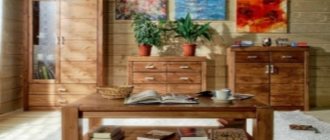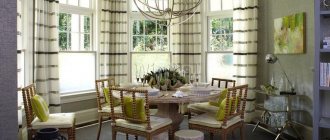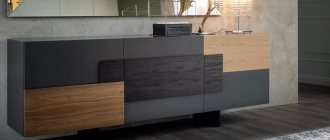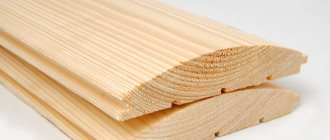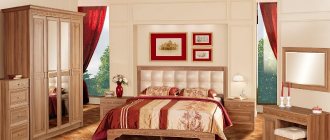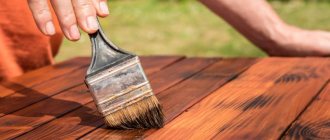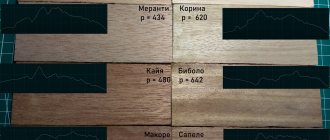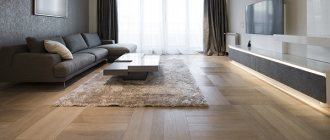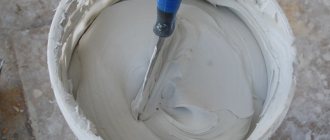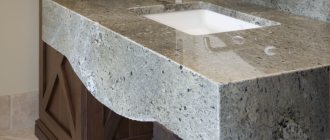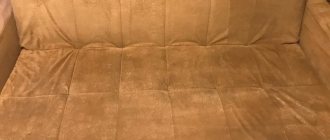Long-term natural processes contribute to the transformation of wood species. This concept can mean not only negative influencing qualities, but also positive ones. As a result of being under water for tens, hundreds of years, or even millennia, oak trunks acquire invaluable qualities, becoming extremely hard and receiving a unique color of a singed or even blackish tint.
Underwater, the integrity of oak is preserved due to a unique characteristic - the presence of a special tannin in the structure of the tree.
Bog oak is a component of a refined and expensive interior.
Features of the reaction
Changes in the physical and mechanical characteristics of wood associated with the passage of complex chemical reactions: leaching of water-soluble substances contained in the cell walls. The process has been proven by the results of numerous studies conducted by N. T. Kuznetsov back in the 30s of the last century.
As a result, it was possible to establish that stained wood contains 75% less water-soluble substances than natural wood. This indicates an increase in cell porosity and a decrease in their density, which results in an increase in the moisture content of the saturation limit, balancing shrinkage, and maximum humidity. It is this factor that explains the absolute shrinkage of boards or workpieces during drying of the sawing material.
The analysis data contributed to the development of thought and the formation of a new technology for drying wood and blanks made from it with a thickness of up to 22-32 mm in a convective or convective-microwave oven, or a vacuum-dielectric drying unit.
The use of advanced technologies has resolved the issue of temperature treatment of wood. There is virtually no internal or external cracking. Collapse in such cases is unacceptable.
The interesting concepts put forward by researchers and scientists do not end there. The study of the properties of stained wood is at the stage of processing geoanalysis data and continues its evolution in the world.
Features of oak extraction and processing
The process is complex and labor-intensive, and not every specialist can handle wood processing. Despite this, the products deserve the highest praise due to their qualities.
Important! If you plan to process or decorate the surface with stained wood, then try to prepare the material in advance. It takes more than one year to process wood.
To obtain such valuable material, water areas of significant volumes are examined, especially the bottom of reservoirs. Moreover, the work is carried out in very difficult conditions.
How is a tree brought to the surface?
Having discovered the trunk, the bog oak is lifted ashore. In this case, it is impossible to do without the use of technology, since one tree weighs around 10-20 tons. Before starting to saw the material, the wood pulled out of the water is assessed at the first stage for quality. Sometimes a tree that has been taken out of the water and prepared for processing is completely unsuitable for further work. As soon as the material is cut, the production of parquet, furniture, doors or window frames immediately begins. Untreated stained wood, kept under water for many years, quickly becomes unusable on the surface. Therefore it must be processed immediately. As you have most likely noticed, extracting bog oak is a labor-intensive process.
Unique characteristics
The oak lives its first life on the shore, the second in the water. The priceless wood is environmentally friendly - it got into the water in the pre-industrial period. After spending at least 300 years under water, bog oak acquires silver and fawn shades. And after 1000 years, the wood becomes almost black, although there are specimens with a purple tint, which allows the products to look even more original. This occurs due to the lack of oxygen supply due to the layer of sand and silt under which the tree rests, and high pressure. At this time, special chemical reactions take place and a natural preservative, tannin, is produced. Oak acquires amazing properties - it becomes hard, almost like stone and resistant to rotting and drying out, and no varnishes or paints are used in the manufacture of products - its texture and color are perfect.
Scope of application of the material
Even if you have never heard of such a material, you can imagine that this type of wood is used in not one, but at least five applications.
Due to the fact that bog oak is a rather rare and even more valuable material, it requires fine manual processing.
Most often, furniture and souvenirs are made from wood, which are doomed to turn into antique objects. It is worth noting that flooring or other types of coatings used in interior design have a long service life.
Benefits of oak wood
Oak wood is a high-quality building material. It is simply impossible to list the list of applications where oak wood is used. It starts from land-based buildings and underwater wooden ships, ending with key chains, cutlery, Chinese chopsticks, vases and other decorative items.
For home use, oak is used to make material for stairs, doors, parquet, cabinets, sofas, kitchen walls and other various household utensils. After all, real strong wood does not rot, repels dust, does not absorb odors, and its service life is at least 10 years.
Oak wood is an excellent building material
The advantage of oak is its pronounced cross-sectional pattern and a wide range of shades, which look very good on home furniture. In addition, oak material is easy to change and process. Thanks to this, in skillful hands you can achieve incredible texture and design.
The natural shades of oak amaze with their diversity and beauty: from pure white to black and charcoal. At the same time, there are no red shades in the range of colors. There are only gold, gray, beige, brown. And these are exactly the colors that will look perfect in your bedroom or kitchen.
Is it possible to produce bog oak under artificial conditions?
Thanks to the development of innovation and the movement of technological progress, changing the natural characteristics, properties and performance of natural wood seems possible. Today, scientists are able to successfully imitate the stained wood color, maintaining aesthetic and durable characteristics, and achieving maximum moisture resistance.
Another option is staining oak at home. This option is simple and affordable and is ideal for those who want to get an unusual oak material with silver veins inside.
For this, stain is useful - a special mixture that imitates the color of natural moraine wood.
Apply the product in two stages: the first time on the surface of the wood at a slight slope, making strokes across the grain, the second - along. During work, use a flat, wide brush - a flute, intended for applying stain and simulating imperceptible natural transitions of tones. This is the best tool, characterized by softness and at the same time elasticity of the pile. Stains are often used to imitate the “stained oak” shade of laminate flooring.
What is included in wood stain?
Impregnation is made on the basis of three components:
- Water. Water-based compounds are better absorbed and are more quickly absorbed by wood. During the processing process, the wood needs to be dried, which takes more time. The result is a uniform shade that can be easily adjusted with a sponge. After waiting for the material to dry completely, it is covered with paint and varnish.
- Ethyl alcohol. It lends itself to instant evaporation, therefore it requires high-quality and quick application and caution in actions. Work with such impregnation only with special gloves and a mask. Otherwise, it will not be possible to achieve uniform tinting of the material. Therefore, craftsmen prefer to work not manually, but using special equipment - a spray gun.
- Alkidov. In addition to obtaining wood in the desired shade, alkyd stain allows you to increase the resistance of the material to external negative factors acting on the material. Therefore, coating the product with varnish can be skipped, except for shine.
Remember that home-dyed raw materials can be easily distinguished from natural bog oak. Therefore, artificial material is often used in baths, saunas, swimming pools, and other rooms with high humidity.
What should you know?
First, we will talk about all the intricacies and stages of extraction/processing of the material, and then we will look at the purposes for which it is used. But let us note right away that all the advantages described above are inherent only in the case when the material was mined and processed according to technology and without deviations.
How the material is extracted
First, figure out exactly how the material gets its unique properties, and this can happen in two cases - either trees growing along the banks of swamps and rivers fall, or individual elements fall out and go to the bottom when logs are floated down rivers. They are usually at the bottom from several tens to hundreds of years old, and there are also oak logs that are over 1000 years old. Everything is simple here - the older the material, the better and more expensive it is.
Material whose age has exceeded 1,000 years is a truly unique phenomenon, and stained oak wood is the rarest wood on earth. As for the extraction of raw materials, it is unlikely that you will be able to cope with this on your own, and the reason for this is the technology that is quite difficult to use.
Technology:
- It should be noted that the largest deposits of wood were found on the territory of Russia, but industrial production is still not properly organized and only a few companies are engaged in such work. This is due to the fact that the process is expensive, labor-intensive, and to extract 100 m3 of really high-quality material, you will need to lift at least 1,000 m3 of wood from the bottom.
From the moment of extraction to the sale of the finished material, the production process takes more than one year, and this requires large investments of capital, and everything will begin to pay off in at least 3 years. For this reason, even large companies cannot afford to start mastering such work.- First, you should conduct a reconnaissance at the bottom to determine where the wood is located. With the help of special echolocation tools, the process is simplified, but it still takes a lot of time, since it is necessary to explore from 300 to 400 kilometers of the riverbed.
- Afterwards, professional divers work to examine the bottom of the reservoir and establish the exact location and number of logs, which allows them to draw up a rough mining plan. The services of workers of this class are not cheap, and this also raises the cost of the material.
- After this, the lifting of wood from the bottom of the rivers begins, and this will require productive equipment, since in rare cases elements of incredible sizes may be encountered. It is impossible to lift some trunks with a crane, especially considering that the density of the material is 1,500 kg/m3. Can you imagine what its physical mass is? Therefore, it is necessary to select equipment in accordance with intelligence data.
- It is also important to understand that work on raising logs to the surface must be carried out very carefully so that there is no damage to the elements, and at the same time, due to pressure changes, a caisson effect can occur, in which the material begins to literally crack before our eyes. For this reason, logs are often lifted and left on the surface of the water to allow the material to stabilize.
Extraction is a complex and extremely responsible process that requires accuracy.
- Afterwards, the elements should be delivered for sawing as quickly as possible, since when exposed to air, even for several hours, the quality of the material decreases sharply. For the same reason, during transportation, you can moisten the wood or transport it in containers with water.
- As for cutting stained wood, it is carried out using special equipment in which the working elements are tipped with carbide to ensure effective cutting of very hard material. Once the wood has dried, it will be more difficult to cut, so it is extremely important to carry out this work on time.
- Finished boards should be stacked in a room where there is no direct sunlight and normal ventilation, and everything should be done while the wood is damp in order to lay it on a flat surface and prevent the wood from deforming.
In order for the material to acquire normal humidity, it should lie in a well-ventilated area for 2 to 4 years. Once the drying has passed, the elements will need to be carefully sorted (this is done by master cabinetmakers), and the wood can be used for any purpose. As you can see, the technology is difficult to implement.
Application area
The finished material is extremely popular and is used in the following areas:
- In the manufacture of high quality wooden furniture, which can decorate any interior, and at the same time its service life is more than 100 years. If you look at it, in rooms with a microclimate that is stable, they can last for an unlimited period of time. Due to the high complexity of processing, projects can only be completed by highly qualified specialists who have all the necessary equipment. Furniture pieces decorated with hand carvings are true works of art.
- Also, incredibly beautiful stairs, finishing coatings and floor elements are made from this raw material. Of course, the cost of such products is high, but true connoisseurs do not take the cost into account, although it will cost a fortune to buy stained wood. This kind of decoration is rarely seen in houses and apartments, and most often it is only found in royal palaces. Such designs can decorate even the most luxurious interior.
- The material is also used to make souvenirs and small items - from knife handles to boxes, figurines and more. The variety is so great that there is no point in listing everything. Here’s an interesting fact: you can order products according to your drawings or design, and receive a unique, one-of-a-kind product.
Please note that production from stained wood is practically waste-free, since high-quality charcoal is made from scraps, and its yield per cubic meter is much higher than when using ordinary wood. This is a good way to use substandard conditions and make a profit from it.
Although some manufacturing companies claim that they have been able to master the technology of artificial staining, the end result is a completely different material that resembles the real one only in appearance.
Why is stained wood popular?
Back in the days when man had just begun to explore the Earth, wood took a reliable ally position as the first available material. No matter how the conditions and the development of scientific and technological progress develop, natural wood has always been in demand, and this trend will remain leading for many centuries to come. Eco-friendly wood is not only safe, but also gives the room a special charm and comfort.
Considering that ordinary wood has become not so interesting in recent years compared to other progressive materials, it’s time to collect laurels for stained wood. In terms of strength characteristics, the material resembles stone due to the properties obtained during the period of being under water.
The color of bog oak is not the main advantage that makes the material preferable in choice. Rested wood is not afraid of cold, moisture, or pests that destroy hectares of forest. Stained material does not require specific care or additional processing. At the same time, it remains the standard of naturalness, environmental friendliness, and purity.
Combination of shades
Natural stained wood cannot be combined with black. An excess of this color is depressing and makes the overall picture too cloudy. This is how stained oak loses its charm. When combining shades, it is better to rely on contrast.
Read also: Pink does not exist
- Black and white . With this combination, you can maximize the advantages and diversity of bog oak. Psychologists believe that this combination is especially attractive to temperamental people. In the interior, the combination of stained oak with white color gives the room a special aristocracy. Designers love to use this technique.
- Black with wenge. The combination of contrasting wood often attracts people with complex personalities, as well as designers who want to create something unique. You can use a checkerboard arrangement or simply change the color of the facades and frames. Situations where stained wood and wenge are used in equal proportions should be avoided. For harmony, it is still worth giving preference to some shade and making it predominant.
- Black with white and red. This contrast is classic. A good solution for minimalism. It is worth noting that other bright accents can be used with stained oak. It’s just that red has already proven itself. In this case, the white color should act as a kind of background; there should be more of it.
In fact, there are a lot of shade combinations . To make the best decision, you should consult with the designer. If you want stained wood to predominate, then you can use artificial material. Otherwise, the interior will be very expensive.
Bog oak parquet with light walls is considered a classic. The surface does not require special care if installed correctly. Moreover, such a floor is not only strong and wear-resistant, but also very durable. You can also lay just stained boards. However, it is parquet that allows you to play with the overall impression, creating drawings.
You cannot place furniture made of this material and lay the floor in the same room. In this case, the interior will be overloaded and gloomy. You should choose one thing.
It is also worth considering that the predominance of black material will make any room visually smaller.
How does it happen that the result is stained wood?
The whole secret is in tannins, which, as a result of the formation of compounds with iron salts, are transformed into super-strong and durable ones. Stained oak boards can be called a reborn material with unique characteristics.
Interesting! Timber has been floated naturally down major rivers all over the world. The banks of the rivers were fortified with oak groves, and when the trunks fell into the water, they remained there to be naturally processed by the elements of nature. About 90% have already been processed, but some of the trees were washed away with silt and remained under water to this day, acquiring even greater value.
Bog oak as a material for creativity
I present to your attention a creative material that many are not yet familiar with - bog oak.
Bog oak is usually called a tree that, for a number of reasons, in its natural form ended up in an aqueous, oxygen-free environment and remained in this “new life” for a long time until it was removed back from the water or peat bog, or sand quarry from great depths.
During long staining, the oak takes on a different color, becoming blue-black with a violet tint and barely noticeable silver veins. Popularly this color is called “crow’s wing” or “anthracite”.
Origin of bog oak.
Bog oak is a unique material that nature spent thousands of years creating; it is mined from the depths of rivers and swamps, in places where oak grew many thousands of years ago. By the will of fate, he did not die in forest fires and was not overcome by disease. As a result of a change in the river bed, the oak tree found itself under a layer of water, where, due to the presence of certain chemical elements in its composition that made it possible to preserve the integrity of the wood, it lived for a huge period of time. And despite the many trials that befell him, he not only survived to this day, but also acquired a number of unique properties and features unique to him. Each bog oak has gone through its own individual, centuries-old path. Therefore, each copy is unique and unrepeatable.
The poison phenol and chemical compounds of tanning oils come out along with water, the texture of the wood becomes denser. Wood after water does not need to be treated with anything, since it has no value for parasites, which is a huge plus. Also, if during life the tree was sick, then a very fast and irreversible process will occur at the bottom of the river, the wood will simply turn into dust, and a healthy tree will lie for centuries, accumulating polyminerals and the positive energy of life and, most importantly, the energy of water.
In general, bog oak amazes the imagination with the history of its creation. Seeing a dried, centuries-old stained tree, you admire the path it had to go through. Particularly striking is the outer layer, consisting of rough plates of natural black coal. You can’t help but think about how much energy was boiling in this tree deep in the water or earth during its second life? How could the outer layer of wood turn into coal without being on fire? And why, already processed, even in the form of a simple polished part, does it radiate soft, gentle energy when touched? After all, it has long been noted that those who come into contact with bog oak are forever captivated by its deep power, beauty and uniqueness.
From my own example, I was convinced that a tree under water can “burn”, becoming overgrown with a layer of coal. In the village where I happen to live at the moment there is a small river along which the red alder tree grows or, as it is commonly called here, “Eloshnik”, wooden spoons are still carved from it, and Semyonov spoons and Khokhloma painting in their time were famous throughout the Soviet Union.
*I’ll write about the stained Eloshnik later, until I’ve studied its properties, let it dry on the shore.
The value of bog oak.
Bog oak is a unique, rare and incredibly expensive wood. It is used to make luxury furniture, parquet flooring and even jewelry, which are extremely strong, unique and durable. It is valued all over the world and its fashion is everlasting, like the fashion for gold and diamonds.
Like gold and platinum from metals, diamond from minerals, bog oak is the most valuable and difficult to obtain of all wood materials created by nature over many centuries and millennia. Its reserves are limited and irreplaceable.
There is no other wood in the world that is equal to bog oak in terms of cultural, historical, religious, and aesthetic parameters. Natural bog oak has long been valued in all countries. Products made from bog oak were recognized decorations in the most exquisite palaces.
But the main value of bog oak is the positive energy charge accumulated over thousands of years by the unique material in different worlds, in the most incredible conditions. By the way, the magic flute from W. A. Mozart’s opera is carved from thousand-year-old oak wood. The magic flute then turns into gold. And cities such as St. Petersburg and Venice still stand on stilts made of oak or larch.
As for the price of this lumber, it reaches half a million per 1 cubic meter. And if we take as an example trunks that are 7-8 thousand years old, then the price will be several times higher, if the volume allows, since very few such trees have been harvested. Once I was asked about the approximate cost if you make carved backgammon + chess to order, I answered that the price of the issue only for the purchase of material would be about 30 thousand rubles, while my reserves are only enough for small crafts, which carry the experience of many years of training in secret knowledge.
From the memories of tender years: I definitely remember in the 90s the Japanese offered to clean up a section of the Volga River, which is at the foot of Nizhny Novgorod (then still the city of Gorky), on condition that they take for themselves everything they find at the bottom. I don’t remember in what form they were asked to forget this idea, but they never got to the treasure of the river. But in addition to the “piece of iron” there is a lot of melted wood, this was one of the main goals of the would-be encroachers from the land of the rising sun. Later I learned that not only the Nizhny Novgorod authorities received similar proposals, but also in other regions.
Oak is one of the most energetically powerful trees in central Russia. Oak in Rus' has always been considered a holy tree, a tree associated with masculine energy and power.
Oak stabilizes the energies of the human body, cleanses the biofield (especially the upper chakras), and fills it with powerful, even, fiery power. The power of oak is akin to the energy of the liver. It helps increase activity and eliminates congestion. The energy of oak has a particularly beneficial effect on the liver itself, on the cardiovascular system and urinary tract, and increases the activity of germ cells (sperm and eggs). Promotes the birth of healthy and strong children.
The Oak Grove is Perun's Grove, where it is not allowed to even break a twig or small twig from the Sacred Oak.
Oak Grove is the first nature reserve where there were no foresters, no guards, no inspectors.
The Thunderer Perun coped with such work very successfully. This order was observed on the land of the Rus-Slavs until recently, while our Ancestors lived in harmony with their own Nature. According to pagan ideas, the strength and freedom of the Rus Tribe lived in Oak. Even our Ancient Wise Magi warned us that if the Sacred Ancestral Oak was cut down, then the entire Family would suffer a difficult fate, including oblivion and death.
Why do I primarily work with this type of wood?
In my work with bog oak, I use certain symbolism, which I carefully select for each product, be it Runes or alchemical signs. The oak lived two lives: its own in the form of a growing tree in the fresh air and, once in water (an oxygen-free environment), it starved in a completely different world for it. When bog oak is removed from the water, it receives a Third Life in the hands of masters of their craft. Having lain for several thousand years at the bottom of a reservoir and passing thousands of tons of water through itself, an enormous amount of energy accumulates in the oak tree, and with the proper application of Sacred symbolism, all this energy begins to act in the right direction
.
The products presented by me (Amulets, rings, cubes) are carved from oak, extracted in the Nizhny Novgorod region from a sand quarry from a depth of 10-15 meters. In accordance with radiocarbon analysis by scientists from the Russian Academy of Sciences (Russian Academy of Sciences), the age of staining of this specimen is 3500 years (plus/minus 50-100 years).
Source
Bog oak is a precious material with a thousand-year history. Unlike ordinary oak, bog oak first grew and bloomed on the ground, and then lay at the bottom of rivers for tens of hundreds of years.
The process of mineralization of oak wood has turned this material into a wonderful, priceless gift to man from nature. Bog oak wood, depending on the degree of mineralization, has shades from dark gray to brown to purple. Moreover, often the middle of the bog oak trunk has a less intense color than the peripheral part. The color of wood changes due to the interaction of tannins contained in solid oak and minerals dissolved in water. Bog oak contains no tannins, and mineral salts of iron oxides in groundwater with tannins (tannic acids of solid oak) form dark compounds that color the wood. In turn, the saturation of the color depends on the amount of tannin and acids contained in the oak and iron in the water, as well as the time the oak remains in the water.
It is also worth paying attention to the water in which the oak was languishing. In the case of intensive circulation of groundwater, the low iron content in water is compensated by the volume of “fresh” substances necessary for the mineralization of the tree.
The environment where oak is stained, among other things, affects the quality of the extracted wood: stained oak, located in the sands of river beds, has better qualities than oak lying in swamps and swamps.
In a stagnant water environment, wood can become “flabby”. In this condition, the core of the tree is rotten, the solid wood has radial cracks. Sometimes such damage affects only part of the trunk, and not the entire length.
Fractures in the wood could also occur when drying out or under low temperatures, to which the oak tree could be exposed until it was completely covered by river waters, when the trunks fell along the floodplain banks due to erosion or recession of waters after a spill.
The extraction and processing of bog oak requires a lot of work.
Bog oak wood is so beautiful that no additional coloring is required to cover it. The exclusive texture of products made from bog oak is unique. The color varies from light gray to black-blue, from soft pink to amber.
Furniture made of bog oak will definitely emphasize the status and good taste of its owner.
Photos provided by our regular lumber supplier
Source
The use of stained wood in construction
Guess why such a house will not be afraid of snow, rain, windy or frosty weather. All thanks to the “school of survival” that the wood underwent at the bottom of the bay, polynya, lake, pond or other body of water where it was located.
The main advantage of building from stained wood is environmental friendliness. It’s hard to imagine an even more natural material for constructing a residential building. Bog oak siding looks interesting.
What makes it a unique material, ideal for construction, is the lack of shrinkage during the drying process. Newly rebuilt housing is completely ready for use without risks to human life and health.
Stained wood in the interior
To create a unique style they often use:
- larch;
- birch;
- oak.
The only requirements for the material used in interior decoration are environmental friendliness and aesthetics, and products made from bog oak fully satisfy these requirements. Often in mansions you can find parquet made of bog oak, which looks unsurpassed.
Wooden buildings of this type are not afraid of any fungi or insects. Therefore, such a coating does not require additional treatment with protective agents, and this is another plus for the environmental friendliness of the house.
The price of wood starts from 12,500 rubles per 1m3. It doesn’t matter how much bog oak costs, the main thing is that the material is of high quality.
Production of furniture from stained wood
The following are best suited for such purposes:
- oak;
- larch;
- birch.
When describing furniture made of bog oak, a simple name is appropriate - “exclusive material”. The tone and texture of natural wood is unique. The depth of color varies: from light gray to black-blue tones, from pale pink to amber shades.
Interesting! Craftsmen compare the pattern of bog oak slices with a map of the starry sky - the same unimaginably beautiful picture.
Unmistakably, such furniture is an unobtrusive but pronounced sign of the taste and specific level of well-being of the owner of the house.
Multi-level floor
Everything you need to know about furniture nails
To zone the space, craftsmen install floors at different levels. They advise installing a podium to separate the kitchen and dining room. This option is considered one of the most practical because, among other things, the owners have additional free space where they can hide something. It is convenient to use boxes or drawers for this. Wicker baskets will look good. But such space can remain free.
However, such a design should not be made if there are small children in the family, since the podium can become an obstacle for him. In addition, various floor coverings can be used. They will zone the space between the living room and the kitchen and protect the podium from damage. For example, tiles are laid in the kitchen area, and laminate flooring in the dining room. The main thing is to choose colors and textures and combine the finishes correctly.
Manufacturing of products from stained wood
Products made from natural wood that have undergone centuries-old natural processing are widely available on the market. From bog wood they produce:
- stairs of any shape;
- windows “stained oak” (shade);
- window sills;
- furniture panels;
- flooring;
- Wall panels;
- tinted doors “stained oak”;
- siding and other materials for exterior construction and home improvement.
Stained wood is an interesting solution for creating a room in a Scandinavian style.
It's nice to look at the interior when there is something unusual in it. Stained wood is the element that fully meets the needs of the designer, creating new and new things to improve human comfort.
Furniture items
Interior sliding doors: mounting options and everything you need to know before installation
A few examples of furnishing a kitchen combined with a living room:
- 1. Sofa. It becomes an object that zones space. The sofa is placed with its back facing the place where food is prepared. In small rooms (less than 20 sq m) a corner is placed, which is placed against a wall installed perpendicular or parallel to the kitchen.
- 2. Set. According to designers, minimalist models without elaborate details look modern. The service, vases or glasses are placed on an open shelf. You can buy a fashionable display case for them. Furniture is placed near the wall. If the space is large (20 sq. m, 25 sq. m or 30 sq. m), then in the central part you can install an island, which also has sections for kitchen appliances.
- 3. Furniture set. The style should be combined with the design of both rooms. In small rooms, a compact table and chairs made of transparent material or painted in light colors look good. You can add a table with a round top to your living room interior. In spacious rooms, the kit is installed near the wall or in the central part. An elongated rectangular dining table would look good here.
